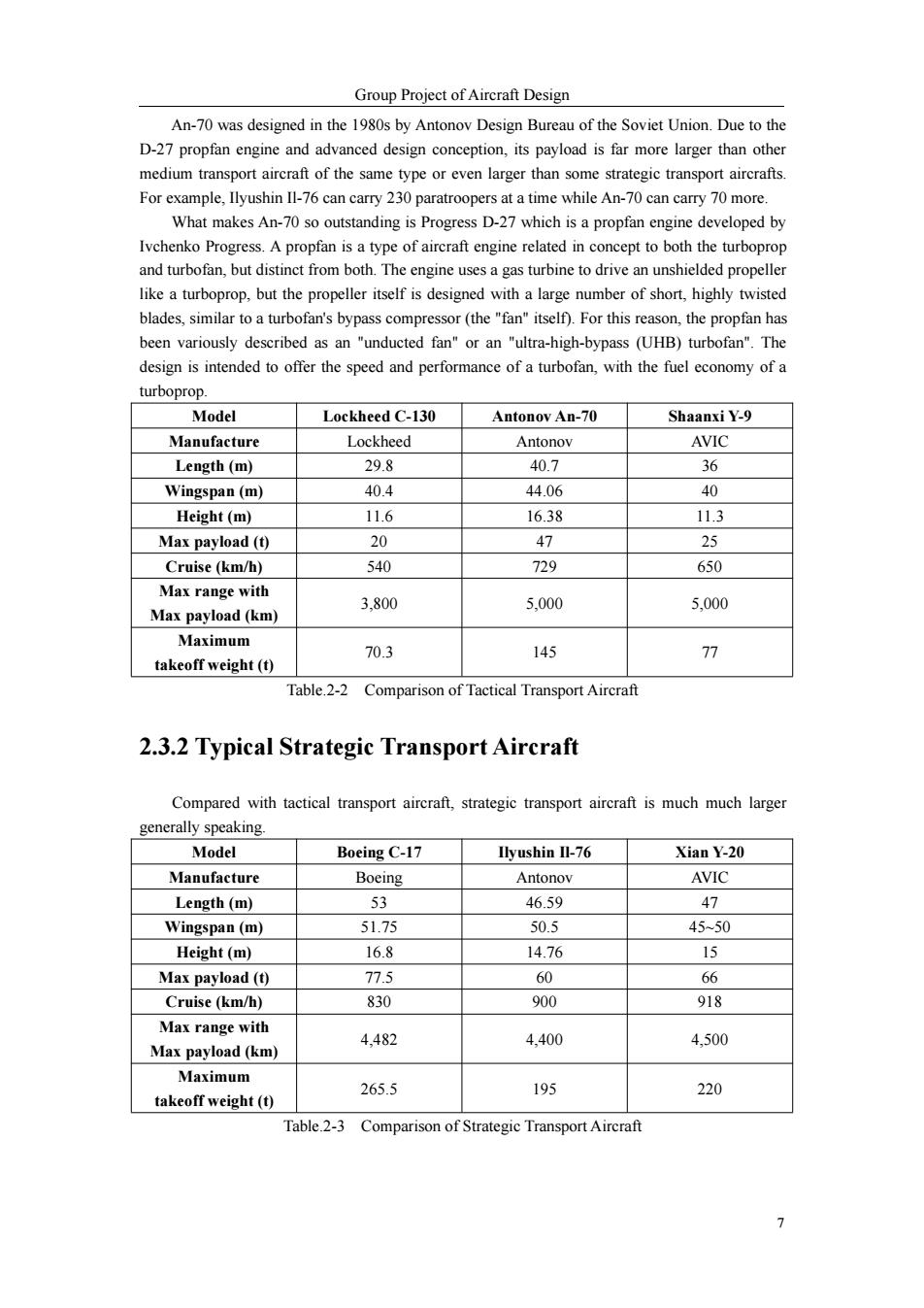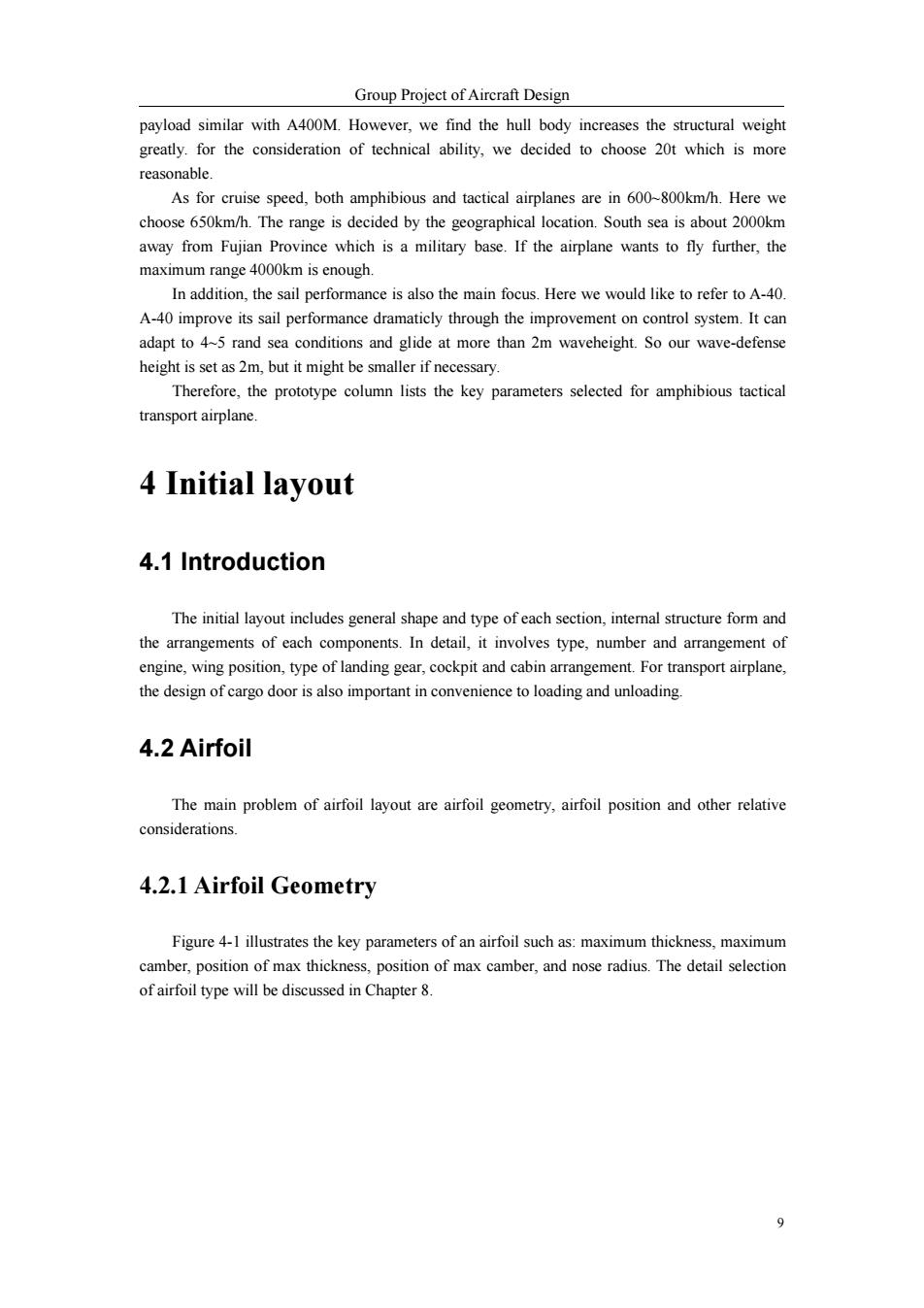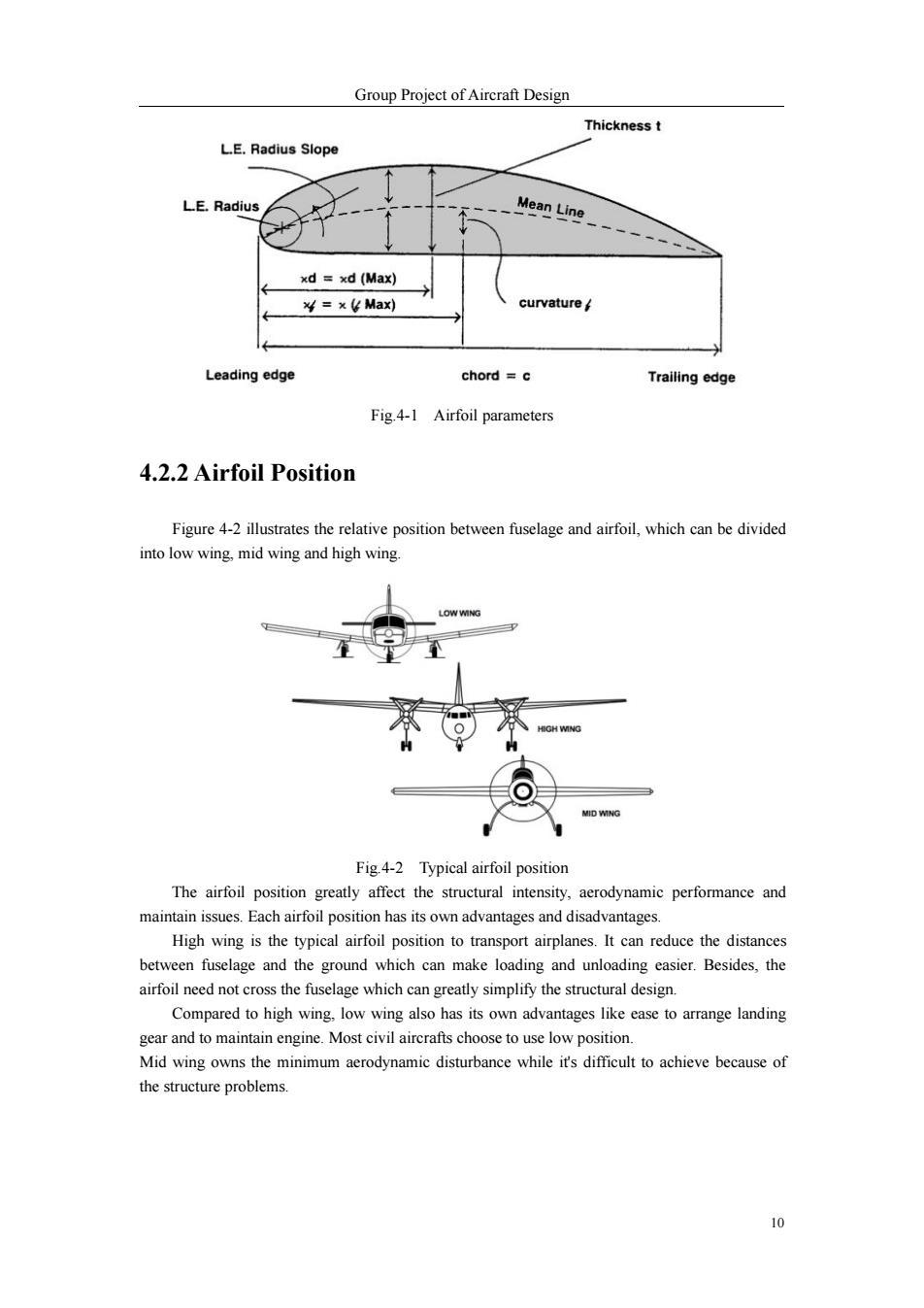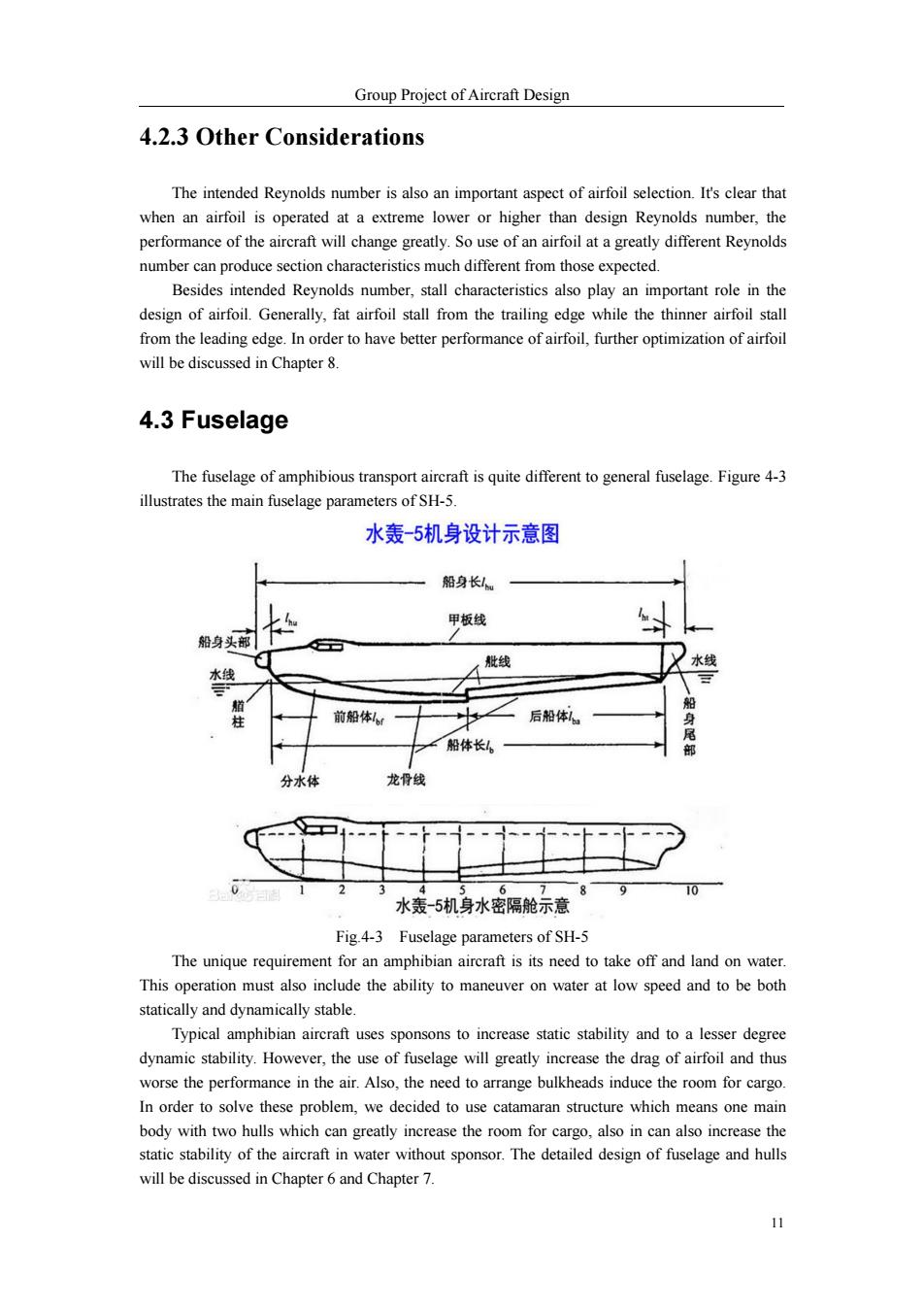
Group Project of Aircraft Design An-70 was designed in the 1980s by Antonov Design Bureau of the Soviet Union.Due to the D-27 propfan engine and advanced design conception,its payload is far more larger than other medium transport aircraft of the same type or even larger than some strategic transport aircrafts. For example,Ilyushin Il-76 can carry 230 paratroopers at a time while An-70 can carry 70 more. What makes An-70 so outstanding is Progress D-27 which is a propfan engine developed by Ivchenko Progress.A propfan is a type of aircraft engine related in concept to both the turboprop and turbofan,but distinct from both.The engine uses a gas turbine to drive an unshielded propeller like a turboprop,but the propeller itself is designed with a large number of short,highly twisted blades,similar to a turbofan's bypass compressor(the"fan"itself).For this reason,the propfan has been variously described as an "unducted fan"or an "ultra-high-bypass (UHB)turbofan".The design is intended to offer the speed and performance of a turbofan,with the fuel economy of a turboprop. Model Lockheed C-130 Antonov An-70 Shaanxi Y-9 Manufacture Lockheed Antonov AVIC Length (m) 29.8 40.7 36 Wingspan(m) 40.4 44.06 40 Height(m) 11.6 16.38 11.3 Max payload(t) 20 47 25 Cruise (km/h) 540 729 650 Max range with 3.800 5,000 5,000 Max payload(km) Maximum 70.3 145 77 takeoff weight(t) Table.2-2 Comparison of Tactical Transport Aircraft 2.3.2 Typical Strategic Transport Aircraft Compared with tactical transport aircraft,strategic transport aircraft is much much larger generally speaking. Model Boeing C-17 Ilyushin Il-76 Xian Y-20 Manufacture Boeing Antonov AVIC Length (m) 53 46.59 47 Wingspan(m) 51.75 50.5 4550 Height(m) 16.8 14.76 15 Max payload(t) 77.5 60 66 Cruise(km/h) 830 900 918 Max range with 4,482 4.400 4,500 Max payload(km) Maximum 265.5 195 220 takeoff weight(t) Table.2-3 Comparison of Strategic Transport Aircraft 7
Group Project of Aircraft Design 7 An-70 was designed in the 1980s by Antonov Design Bureau of the Soviet Union. Due to the D-27 propfan engine and advanced design conception, its payload is far more larger than other medium transport aircraft of the same type or even larger than some strategic transport aircrafts. For example, Ilyushin Il-76 can carry 230 paratroopers at a time while An-70 can carry 70 more. What makes An-70 so outstanding is Progress D-27 which is a propfan engine developed by Ivchenko Progress. A propfan is a type of aircraft engine related in concept to both the turboprop and turbofan, but distinct from both. The engine uses a gas turbine to drive an unshielded propeller like a turboprop, but the propeller itself is designed with a large number of short, highly twisted blades, similar to a turbofan's bypass compressor (the "fan" itself). For this reason, the propfan has been variously described as an "unducted fan" or an "ultra-high-bypass (UHB) turbofan". The design is intended to offer the speed and performance of a turbofan, with the fuel economy of a turboprop. Model Lockheed C-130 Antonov An-70 Shaanxi Y-9 Manufacture Lockheed Antonov AVIC Length (m) 29.8 40.7 36 Wingspan (m) 40.4 44.06 40 Height (m) 11.6 16.38 11.3 Max payload (t) 20 47 25 Cruise (km/h) 540 729 650 Max range with Max payload (km) 3,800 5,000 5,000 Maximum takeoff weight (t) 70.3 145 77 Table.2-2 Comparison of Tactical Transport Aircraft 2.3.2 Typical Strategic Transport Aircraft Compared with tactical transport aircraft, strategic transport aircraft is much much larger generally speaking. Model Boeing C-17 Ilyushin Il-76 Xian Y-20 Manufacture Boeing Antonov AVIC Length (m) 53 46.59 47 Wingspan (m) 51.75 50.5 45~50 Height (m) 16.8 14.76 15 Max payload (t) 77.5 60 66 Cruise (km/h) 830 900 918 Max range with Max payload (km) 4,482 4,400 4,500 Maximum takeoff weight (t) 265.5 195 220 Table.2-3 Comparison of Strategic Transport Aircraft

Group Project of Aircraft Design 2.4 Seaplane Seaplane is a kind of plane which can take off and land on water.It has its great advantages flying above seas or areas with plenty of lakes and rivers.There is nearly no taking off and landing limitations for seaplanes except for a fine weather like other planes requires.But because of its unique structures for moving on water,it has larger structure weight than others. Model Be-200 SH-5 AG600 Length (m) 32.0 38.9 Wingspan (m) 32.8 36 Height(m) 8.9 9.8 Max payload(water)(t) 12 9 Cruise (km/h) 560 555 Max range with 2,100 4,900 5,300 Max payload (km) Maximum takeoff 37.9 45 48 weight(water)(t) Table.2-4 Comparison of Seaplanes 3 Primary Parameters Determination To determine the key performance parameters of our amphibious tactical transport,we first invesgate the existing similar transport airplanes in the world,such as amphibious airplanes: Be-200,SH-5,A-40,tactical transport aircrafts:Y-9,An-70,A400M. Model Be-200 A-40 SH-5 Y-9 A400M Prototype Length (m) 32 43.84 38.9 36 45.1 Wingspan (m) 32.8 41.26 36 40 43.4 Height (m) 8.9 11 9.8 11.3 14.7 Payload (t) 7.5 6.5 9 25 37 20 Cruise 560 800 <556 650 780 650 speed(km/h) Range (km) 2,100 4,100 4.900 7800 9000 4.000 Max.takeoff 41L) 86 45 77 141 weight (t) 37W Table.3-1 Key parameters of similar aircraft Our amphibious tactical aircraft aims at combine the advantages of both amphibious and tactical aircraft,which will takeoff and landing on both land and water at short distance.As a military aircraft,short takeoff distance is the basic requirement.We set the takeoff distance as 1000m with max payload on land,350m without payload on land. It should load more compared with amphibious aircraft because its primary function is to carry cargo.Therefore,we set its payload as 20t.In fact,at the very beginning,we chose 35t 8
Group Project of Aircraft Design 8 2.4 Seaplane Seaplane is a kind of plane which can take off and land on water. It has its great advantages flying above seas or areas with plenty of lakes and rivers. There is nearly no taking off and landing limitations for seaplanes except for a fine weather like other planes requires. But because of its unique structures for moving on water, it has larger structure weight than others. Model Be-200 SH-5 AG600 Length (m) 32.0 38.9 - Wingspan (m) 32.8 36 - Height (m) 8.9 9.8 - Max payload(water) (t) 12 9 - Cruise (km/h) 560 - 555 Max range with Max payload (km) 2,100 4,900 5,300 Maximum takeoff weight(water) (t) 37.9 45 48 Table.2-4 Comparison of Seaplanes 3 Primary Parameters Determination To determine the key performance parameters of our amphibious tactical transport, we first invesgate the existing similar transport airplanes in the world, such as amphibious airplanes: Be-200, SH-5, A-40, tactical transport aircrafts: Y-9, An-70, A400M. Model Be-200 A-40 SH-5 Y-9 A400M Prototype Length(m) 32 43.84 38.9 36 45.1 Wingspan(m) 32.8 41.26 36 40 43.4 Height(m) 8.9 11 9.8 11.3 14.7 - Payload(t) 7.5 6.5 9 25 37 20 Cruise speed(km/h) 560 800 <556 650 780 650 Range(km) 2,100 4,100 4,900 7800 9000 4,000 Max. takeoff weight(t) 41(L) 37(W) 86 45 77 141 Table.3-1 Key parameters of similar aircraft Our amphibious tactical aircraft aims at combine the advantages of both amphibious and tactical aircraft, which will takeoff and landing on both land and water at short distance. As a military aircraft, short takeoff distance is the basic requirement. We set the takeoff distance as 1000m with max payload on land, 350m without payload on land. It should load more compared with amphibious aircraft because its primary function is to carry cargo. Therefore, we set its payload as 20t. In fact, at the very beginning, we chose 35t

Group Project of Aircraft Design payload similar with A400M.However,we find the hull body increases the structural weight greatly.for the consideration of technical ability,we decided to choose 20t which is more reasonable. As for cruise speed,both amphibious and tactical airplanes are in 600~800km/h.Here we choose 650km/h.The range is decided by the geographical location.South sea is about 2000km away from Fujian Province which is a military base.If the airplane wants to fly further,the maximum range 4000km is enough. In addition,the sail performance is also the main focus.Here we would like to refer to A-40. A-40 improve its sail performance dramaticly through the improvement on control system.It can adapt to 4~5 rand sea conditions and glide at more than 2m waveheight.So our wave-defense height is set as 2m,but it might be smaller if necessary. Therefore,the prototype column lists the key parameters selected for amphibious tactical transport airplane. 4 Initial layout 4.1 Introduction The initial layout includes general shape and type of each section,internal structure form and the arrangements of each components.In detail,it involves type,number and arrangement of engine,wing position,type of landing gear,cockpit and cabin arrangement.For transport airplane, the design of cargo door is also important in convenience to loading and unloading. 4.2 Airfoil The main problem of airfoil layout are airfoil geometry,airfoil position and other relative considerations. 4.2.1 Airfoil Geometry Figure 4-1 illustrates the key parameters of an airfoil such as:maximum thickness,maximum camber,position of max thickness,position of max camber,and nose radius.The detail selection of airfoil type will be discussed in Chapter 8. 9
Group Project of Aircraft Design 9 payload similar with A400M. However, we find the hull body increases the structural weight greatly. for the consideration of technical ability, we decided to choose 20t which is more reasonable. As for cruise speed, both amphibious and tactical airplanes are in 600~800km/h. Here we choose 650km/h. The range is decided by the geographical location. South sea is about 2000km away from Fujian Province which is a military base. If the airplane wants to fly further, the maximum range 4000km is enough. In addition, the sail performance is also the main focus. Here we would like to refer to A-40. A-40 improve its sail performance dramaticly through the improvement on control system. It can adapt to 4~5 rand sea conditions and glide at more than 2m waveheight. So our wave-defense height is set as 2m, but it might be smaller if necessary. Therefore, the prototype column lists the key parameters selected for amphibious tactical transport airplane. 4 Initial layout 4.1 Introduction The initial layout includes general shape and type of each section, internal structure form and the arrangements of each components. In detail, it involves type, number and arrangement of engine, wing position, type of landing gear, cockpit and cabin arrangement. For transport airplane, the design of cargo door is also important in convenience to loading and unloading. 4.2 Airfoil The main problem of airfoil layout are airfoil geometry, airfoil position and other relative considerations. 4.2.1 Airfoil Geometry Figure 4-1 illustrates the key parameters of an airfoil such as: maximum thickness, maximum camber, position of max thickness, position of max camber, and nose radius. The detail selection of airfoil type will be discussed in Chapter 8

Group Project of Aircraft Design Thickness t L.E.Radius Slope LE.Radius Mean Line xd xd (Max) =x(Max) curvature/ Leading edge chord c Trailing edge Fig.4-1 Airfoil parameters 4.2.2 Airfoil Position Figure 4-2 illustrates the relative position between fuselage and airfoil,which can be divided into low wing,mid wing and high wing. LOW WING MID WING Fig.4-2 Typical airfoil position The airfoil position greatly affect the structural intensity,aerodynamic performance and maintain issues.Each airfoil position has its own advantages and disadvantages. High wing is the typical airfoil position to transport airplanes.It can reduce the distances between fuselage and the ground which can make loading and unloading easier.Besides,the airfoil need not cross the fuselage which can greatly simplify the structural design. Compared to high wing,low wing also has its own advantages like ease to arrange landing gear and to maintain engine.Most civil aircrafts choose to use low position. Mid wing owns the minimum aerodynamic disturbance while it's difficult to achieve because of the structure problems. o
Group Project of Aircraft Design 10 Fig.4-1 Airfoil parameters 4.2.2 Airfoil Position Figure 4-2 illustrates the relative position between fuselage and airfoil, which can be divided into low wing, mid wing and high wing. Fig.4-2 Typical airfoil position The airfoil position greatly affect the structural intensity, aerodynamic performance and maintain issues. Each airfoil position has its own advantages and disadvantages. High wing is the typical airfoil position to transport airplanes. It can reduce the distances between fuselage and the ground which can make loading and unloading easier. Besides, the airfoil need not cross the fuselage which can greatly simplify the structural design. Compared to high wing, low wing also has its own advantages like ease to arrange landing gear and to maintain engine. Most civil aircrafts choose to use low position. Mid wing owns the minimum aerodynamic disturbance while it's difficult to achieve because of the structure problems

Group Project of Aircraft Design 4.2.3 Other Considerations The intended Reynolds number is also an important aspect of airfoil selection.It's clear that when an airfoil is operated at a extreme lower or higher than design Reynolds number,the performance of the aircraft will change greatly.So use of an airfoil at a greatly different Reynolds number can produce section characteristics much different from those expected. Besides intended Reynolds number,stall characteristics also play an important role in the design of airfoil.Generally,fat airfoil stall from the trailing edge while the thinner airfoil stall from the leading edge.In order to have better performance of airfoil,further optimization of airfoil will be discussed in Chapter 8. 4.3 Fuselage The fuselage of amphibious transport aircraft is quite different to general fuselage.Figure 4-3 illustrates the main fuselage parameters of SH-5. 水轰-5机身设计示意图 船身长 甲板线 船身头部 批线 水线 水线 船 前船体 后船体 身 船体长。 部 分水体 龙骨线 0 10 水轰-5机身水密隔舱示意 Fig.4-3 Fuselage parameters of SH-5 The unique requirement for an amphibian aircraft is its need to take off and land on water This operation must also include the ability to maneuver on water at low speed and to be both statically and dynamically stable. Typical amphibian aircraft uses sponsons to increase static stability and to a lesser degree dynamic stability.However,the use of fuselage will greatly increase the drag of airfoil and thus worse the performance in the air.Also,the need to arrange bulkheads induce the room for cargo. In order to solve these problem,we decided to use catamaran structure which means one main body with two hulls which can greatly increase the room for cargo,also in can also increase the static stability of the aircraft in water without sponsor.The detailed design of fuselage and hulls will be discussed in Chapter 6 and Chapter 7
Group Project of Aircraft Design 11 4.2.3 Other Considerations The intended Reynolds number is also an important aspect of airfoil selection. It's clear that when an airfoil is operated at a extreme lower or higher than design Reynolds number, the performance of the aircraft will change greatly. So use of an airfoil at a greatly different Reynolds number can produce section characteristics much different from those expected. Besides intended Reynolds number, stall characteristics also play an important role in the design of airfoil. Generally, fat airfoil stall from the trailing edge while the thinner airfoil stall from the leading edge. In order to have better performance of airfoil, further optimization of airfoil will be discussed in Chapter 8. 4.3 Fuselage The fuselage of amphibious transport aircraft is quite different to general fuselage. Figure 4-3 illustrates the main fuselage parameters of SH-5. Fig.4-3 Fuselage parameters of SH-5 The unique requirement for an amphibian aircraft is its need to take off and land on water. This operation must also include the ability to maneuver on water at low speed and to be both statically and dynamically stable. Typical amphibian aircraft uses sponsons to increase static stability and to a lesser degree dynamic stability. However, the use of fuselage will greatly increase the drag of airfoil and thus worse the performance in the air. Also, the need to arrange bulkheads induce the room for cargo. In order to solve these problem, we decided to use catamaran structure which means one main body with two hulls which can greatly increase the room for cargo, also in can also increase the static stability of the aircraft in water without sponsor. The detailed design of fuselage and hulls will be discussed in Chapter 6 and Chapter 7